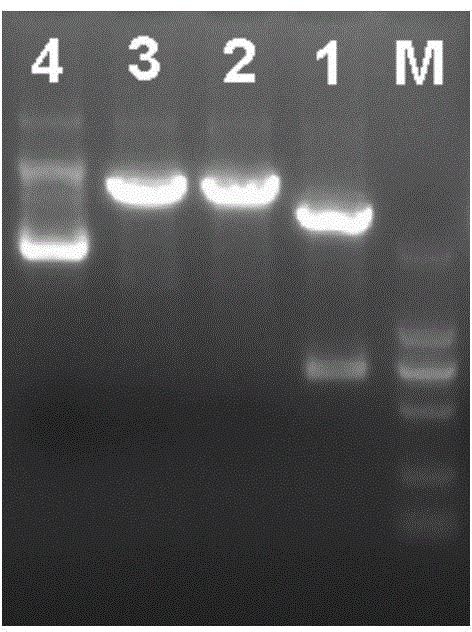Duck plague virus (DPV) UL13 intercepted recombinant protein and polyclonal antibody, preparation method and application thereof
A technology of polyclonal antibody and duck plague virus, which is applied in the field of genetic engineering, can solve the problems of complex whole virus antigen purification methods, affecting the accuracy of test results, poor stability, etc., and achieves good product purity and stability, low production cost, highly specific effect
- Summary
- Abstract
- Description
- Claims
- Application Information
AI Technical Summary
Problems solved by technology
Method used
Image
Examples
Embodiment 1
[0033] Cloning of embodiment 1, DPV UL13 truncated gene
[0034] 1. Primer design and synthesis
[0035] According to the nucleotide sequence corresponding to amino acids 163 to 386 in the UL13 gene coding protein sequence (SEQ ID No.1, named pUL13), the following primers were designed with Oligo6.0 software: Upstream primer: 5'- ggatcc ctggtggctacggagag-3' (SEQ ID NO.3), the underlined part is the BamH I site, this primer is an optimized primer obtained by replacing the original C base with the merged T base; downstream primer: 5'- aagctt ccaagggcgtatatgtc-3' (SEQ ID NO.4), the underlined part is the Hind III site. The primers were synthesized, dissolved in sterilized deionized water to make a solution with a concentration of 10 pmol / L, and stored at -20°C for future use.
[0036] 2. Extraction of DPV genomic DNA
[0037] a. Preparation of duck embryo fibroblasts (DEF): take 10-day-old healthy duck embryos, disinfect the surface of the eggshell with 5% (v / v) iodine and 7...
Embodiment 2
[0043] Embodiment 2, the construction of recombinant prokaryotic expression plasmid
[0044] The pUC19-UL13 plasmid and the pET32c(+) vector were digested with BamH I and Hind III respectively, and the DPV UL13 truncated gene and the pET32c(+) linear fragment were recovered, and ligated overnight at 16°C under the action of DNA ligase. Transform the cloned host strain E.coli DH5α competent cells with the ligation product, inoculate the obtained transformation product on the LB agar plate containing ampicillin (Amp), cultivate overnight at 37°C, pick a single white colony and inoculate it on the LB liquid containing Amp the next day In the culture medium, shake culture in a water bath at 37°C for 18 hours, extract the plasmid, and carry out PCR and enzyme digestion identification. The positive recombinant plasmid obtained is the recombinant prokaryotic expression plasmid, named pET32c-UL13. For enzyme digestion results, see image 3 , it can be seen that the recombinant prokar...
Embodiment 3
[0045] Embodiment 3, the construction of recombinant prokaryotic expression engineering bacteria
[0046] Pick the cloned engineered bacteria DH5α containing the recombinant plasmid pET32c-UL13, streak and inoculate it on the LB agar plate containing Amp, culture it overnight at 37°C, take a single colony and inoculate it in the LB liquid medium the next day, and culture it vigorously for 10-16 hours , extract the plasmid, transform and express the host strain E.coli BL21 (DE3) competent cells, inoculate the obtained transformation product on the LB agar plate containing Amp, cultivate overnight at 37°C, screen positive clones the next day, and obtain the recombinant plasmid pET32c - UL13 expression engineering bacteria BL21 (DE3).
PUM
 Login to View More
Login to View More Abstract
Description
Claims
Application Information
 Login to View More
Login to View More - R&D
- Intellectual Property
- Life Sciences
- Materials
- Tech Scout
- Unparalleled Data Quality
- Higher Quality Content
- 60% Fewer Hallucinations
Browse by: Latest US Patents, China's latest patents, Technical Efficacy Thesaurus, Application Domain, Technology Topic, Popular Technical Reports.
© 2025 PatSnap. All rights reserved.Legal|Privacy policy|Modern Slavery Act Transparency Statement|Sitemap|About US| Contact US: help@patsnap.com



